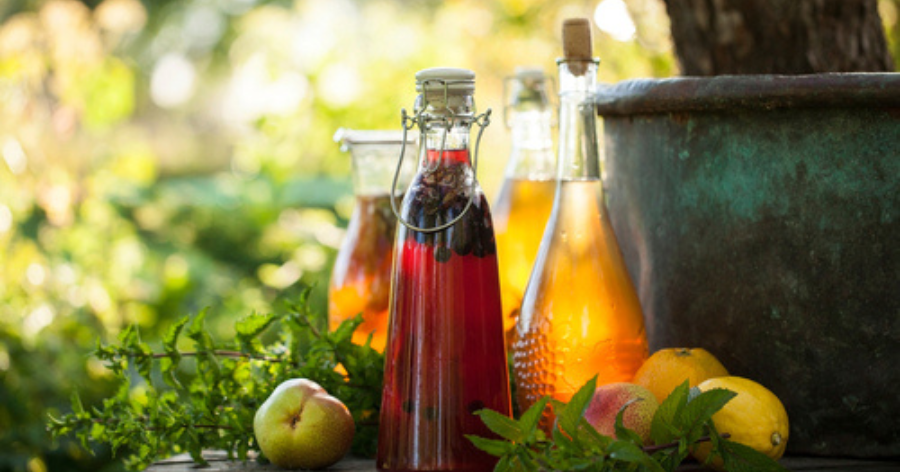
DIY Flavored Kombucha Recipes
Share
Easy second fermentation flavors using ginger, turmeric, and berries
Want to create your own delicious kombucha at home? Flavoring kombucha after its first fermentation is not only fun but also allows you to boost its health benefits and control its taste and fizz.
In this guide, you’ll learn how to flavor your homemade kombucha using ginger, turmeric, and berries—three powerhouse ingredients that bring wellness and flavor to your homemade beverage.
Even homebrewers deserve a day off. Click here to see our kombucha collection!
Why Flavor Kombucha at Home?
1. Custom Taste, Every Time
Flavoring at home gives you full control. Whether you love spicy ginger, fruity berries, or healthful turmeric, you can design a kombucha that fits your personal taste without artificial flavors or added sugars.
2. Enhanced Health Benefits
Adding superfoods like ginger and turmeric increases the antioxidant, anti-inflammatory, and digestive-supporting qualities of your brew. Fresh fruit also boosts the vitamin content and polyphenol activity.
3. Natural Carbonation
Second fermentation (also called “F2”) lets your kombucha carbonate naturally. The sugars from the fruit or sweeteners feed the yeast, creating bubbles—no added carbonation needed.
4. Budget-Friendly
Homemade kombucha costs just pennies per serving compared to $3–$5 store-bought bottles. Flavoring it yourself adds variety without spending more.
What You’ll Need
-
First fermentation kombucha (fermented for 7 to 10 days until tart)
-
Clean, airtight 16 oz glass bottles with swing-top or tight-sealing caps
- Flavoring ingredients:
- Ginger: 1 teaspoon fresh grated per bottle
-
Turmeric: ¼ teaspoon ground or ½ teaspoon fresh grated
-
Berries: ¼ cup crushed strawberries, blueberries, raspberries, etc.
-
Optional sweetener: honey, maple syrup, or fruit juice (1–2 tablespoons)
-
Funnel and mesh strainer
- Clean work area and sanitized equipment
Try one of customer favorites today, Blackberry Sangria! Buy now.
Step-by-Step Flavoring Instructions
Step 1: Prep Your Bottles
Make sure bottles are sanitized to prevent mold or contamination. Pour off up to 20 percent of your brewed kombucha to save as starter for your next batch.
Step 2: Add Flavors
Ginger Kombucha
-
Add 1 teaspoon of freshly grated ginger root to each bottle. For more spice, increase slightly.
Turmeric Kombucha
-
Add ¼ teaspoon of ground turmeric or ½ teaspoon of fresh grated turmeric per bottle. A pinch of black pepper may boost curcumin absorption.
Berry Kombucha
-
Add ¼ cup of crushed berries per bottle. Use a single fruit or mix (e.g., strawberry and blueberry).
Optional
- Add 1 to 2 tablespoons of juice or sweetener to boost carbonation and sweetness.
Take home our latest and greatest flavor, Blueberry Crumble. Shop now.
Step 3: Second Fermentation
-
Use a funnel to pour kombucha into the bottles, leaving about ½ inch of space at the top.
-
Seal bottles tightly.
-
Store at room temperature (70 to 75°F) away from direct sunlight for 2 to 7 days.
-
After 2 to 3 days, “burp” the bottles (open briefly) to release built-up gas and prevent explosions.
-
Check for fizz daily.
Step 4: Strain, Chill, and Enjoy
-
Once carbonation is to your liking, refrigerate bottles to slow fermentation.
-
Strain out fruit or spice bits before serving to keep your kombucha smooth.
-
Enjoy cold.
Why These Ingredients Work
Ginger Kombucha
Ginger is known for its gut-soothing, anti-nausea properties. When combined with the probiotics in kombucha, it may support digestion and immune health.
Animal studies have shown that ginger-flavored kombucha can increase antioxidant enzyme activity (SOD, catalase, and GSH), helping protect against oxidative stress.
Turmeric Kombucha
Turmeric contains curcumin, a compound with strong anti-inflammatory and antibacterial properties. A 2024 study found that turmeric-flavored kombucha helped improve gut microbiota balance and reduced markers of inflammation in mice.
Berry Kombucha
Berries are rich in vitamins, antioxidants, and natural sugars. They add color, flavor, and fizz to your kombucha.
Crushed berries or berry juice can also promote higher carbonation levels during second fermentation, creating a light and refreshing drink.
Tips for the Best Results
-
Fruit ratio: Aim for 10 to 30 percent fruit per bottle or ½ cup juice per liter. This provides enough sugar to ferment without over-carbonating.
-
Watch pressure: Burp bottles every day after the second day to prevent pressure build-up. Use plastic test bottles if you’re unsure.
-
Strain before drinking: Keeps sediment and pulp out of your final drink for a smoother taste.
-
Clean everything: Sanitize bottles, caps, and tools before use. A contaminated batch can ruin weeks of brewing.
Frequently Asked Questions
Can I combine flavors, like ginger and berries?
Yes. Ginger and berries complement each other well. Try ½ teaspoon ginger with ⅛ cup crushed berries for a balanced, spicy-sweet blend.
What if the bottle over-carbonates or explodes?
This means there was too much sugar or it fermented too long in a warm space. Open bottles daily during fermentation to release gas, and refrigerate sooner next time.
Will turmeric stain my bottle or kombucha?
Yes. Expect a golden-yellow hue—this is natural and harmless. It may stain plastic, so use glass bottles when possible.
Flavoring kombucha at home with ginger, turmeric, or berries is one of the easiest and most rewarding ways to personalize your brewing process.
These ingredients not only enhance taste and fizz but also bring added health benefits like antioxidants, anti-inflammatory compounds, and digestive support.
With a little trial and error, you can master the art of second fermentation and enjoy a delicious, probiotic-rich beverage that’s completely your own.
Sources
Effect of Ginger-Enriched Kombucha on Antioxidant Enzymes in Mice
https://pubmed.ncbi.nlm.nih.gov/29055172/
Turmeric-Fermented Kombucha Supports Gut Microbiota and Reduces Inflammation https://www.mdpi.com/1422-0067/24/18/13984
Health Benefits of Ginger – Cleveland Clinic https://health.clevelandclinic.org/ginger-health-benefits
Turmeric and Curcumin for Inflammation – Mayo Clinic https://newsnetwork.mayoclinic.org/discussion/mayo-clinic-q-and-a-turmeric-for-healthier-diet-pain-relief/
The Benefits of Berries – Healthline https://www.healthline.com/nutrition/11-reasons-to-eat-berries
Fermented Foods and Kombucha – NIH Overview https://pmc.ncbi.nlm.nih.gov/articles/PMC9975612/
